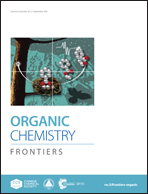Stable dicationic dioxoliums and fate of their dioxolyl radicals†
Abstract
Stable dicationic dioxolium salts featuring an ancillary vinamidinium pattern were synthesized and characterized. Although highly reactive, they were found otherwise easy to handle under inert atmosphere. This offered the opportunity to generate and study the fate of unknown 1,3-dioxolyl radicals. Depending on substituents, reduction led to the formation of dimers of either dioxolyl or cyclohexadienyl radicals, stemming from a process that is related to the Surzur–Tanner rearrangement. The cyclohexadienyl radical could be characterized in the case of a tri(tert-butyl)phenyl group, which prevents dimerization processes.

- This article is part of the themed collection: FOCUS: Radical-involved chemical transformations


 Please wait while we load your content...
Please wait while we load your content...